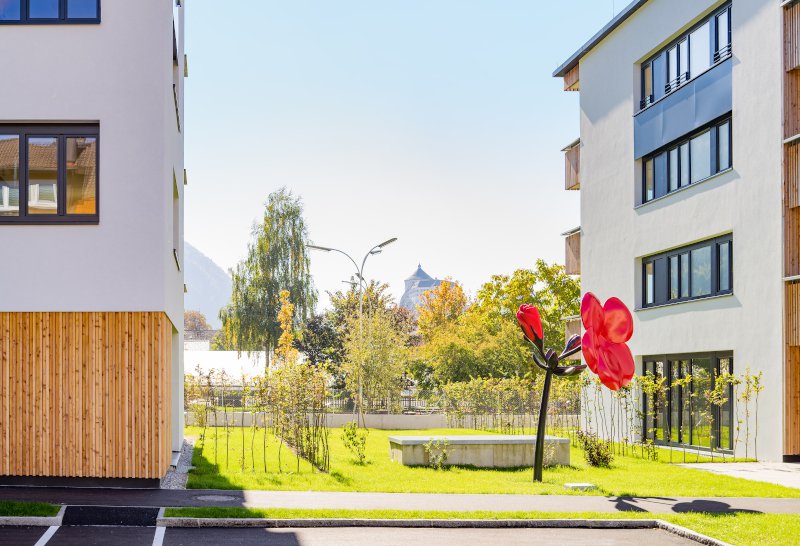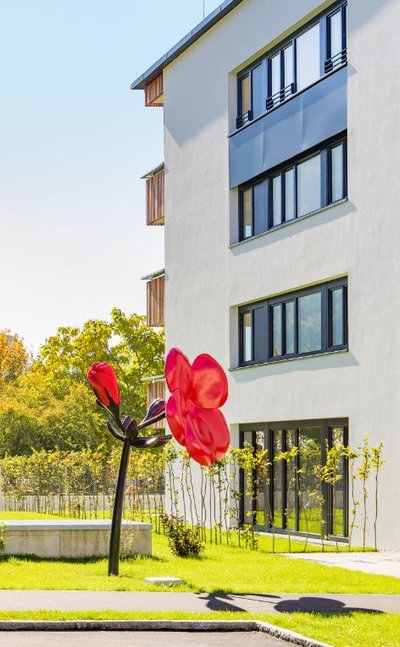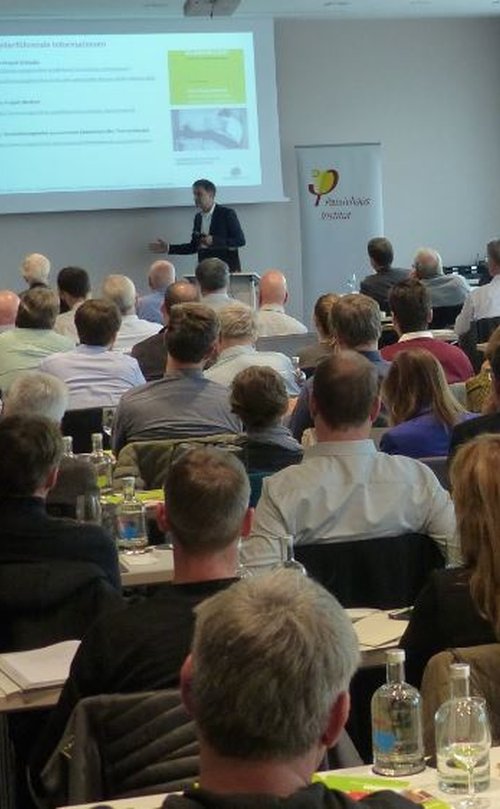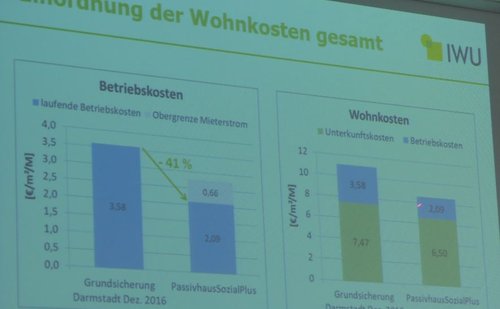The effort is definitely worth it!
How social housing can be realised in an energy efficient and cost-effective way
Darmstadt, Germany. Low operational costs for heating and electricity and a high standard of living comfort are possible at the same time: the latest session of the Research Group for cost-effective Passive Houses addressed the issue of social housing and how it can be implemented in a cost-effective and energy efficient manner. During an associated excursion, many parti-cipants visited the PassivhausSozial-Plus in Darmstadt which is a nationwide model project for social housing.

Many municipalities, particularly in high-density urban areas, are tackling the urgent task of providing more affordable housing. Although government subsidies are often available for energy-efficient buildings, investments in energy efficiency especially are perceived to be a major factor for increased costs by the property developers. "Generally speaking, it is not enough to only consider the investment costs for construction. The auxiliary costs are of crucial importance for socially acceptable rents," explains Oliver Kah of the Passive House Institute. The session of the Research Group on social housing initiated by the Passive House Institute dealt with both cost segments.
Active climate protection
Dr Wolfgang Feist, founder of the Passive House Institute, has pointed out that energy efficient housing construction helps in achieving climate protection objectives. "Noticeable success has already been achieved through better energy efficiency. These solutions must now be applied with commitment."

Savings potentials
During the 55th Session of the Research Group for cost-effective Passive Houses, Esther Gollwitzer of the Passive House Institute identified the saving potential and cost drivers for housing construction. Based on the example of already realised multi-storey residential buildings, she showed that the construction costs fluctuate considerably even with the same energy standard. This might be due to different building designs, for example. However, Gollwitzer emphasised that energy efficiency measures have only a small impact on the total costs of the building and mentioned that these additional costs amount to about four to seven per cent for building to the Passive House standard.

Attractive subsidy programmes
"But these investments for higher energy efficiency can often be reduced significantly through subsidy programmes, in contrast to the increasing costs for building facilities," explained Oliver Kah of the Passive House Institute. In his presentation, Kah examined the total costs for a new building. He precisely calculated how prices for the building land or an underground garage are rising, and how costs for building more energy efficiently, including a good level of insulation, can affect the costs for the DIN 276 construction cost group 300-400 and hence also the rent later on.
Happy residents
According to Kah, energy efficient buildings are attractive for residents as well. Housing construction companies report that the risk of vacant properties is very small in the case of Passive House homes due to their low auxiliary costs and the high standard of living comfort at the same time. Marc Großklos from the IWU (Institute of Housing and the Environment) and Passive House designer Folker Rasch discussed the PassivhausSozialPlus in Darmstadt as a key focus of the Research Group.

Nationwide model project
The PassivhausSozialPlus in Darmstadt is a nationwide model project and was also the focus of an excursion during the Passive House Open Days. This social housing project aims for auxiliary rental costs of two Euros per square metre of living space on average. These costs will be charged as a fixed fee and will include the costs for electricity, hot water and internet use. The excursion’s participants were impressed by this project which consists of two apartment blocks, of which one is a retrofitted building and the other one is a new build. Both buildings are equipped with a photovoltaic system and battery storage.
Subsidies are available
For the Energy Agency of the state of Hesse (LEA), Christian Kuhlmann outlined the subsidies available for extremely energy efficient buildings, including those for modernisation of existing buildings to the Passive House standard. Kuhlmann confirmed that numerous grants are available. The non-profit housing development association Neue Heimat Tirol (NHT) specialises in social housing. Harald Malzer presented various projects of the NHT including the model 5-Euro-Miete ("5 euro rent") of a Passive House building in Schwaz, Tyrol.

Works of art for social housing
The 18 apartments in this Passive House project are rented out by the NHT for a monthly amount of just five Euros per square metre to cover costs, including heating. The NHT also endeavours to create a welcoming atmosphere in the buildings and incorporates a piece of art into each property to enhance this, says Malzer.
Most economically efficient option
Ralf Werner presented new buildings and energy retrofits of the Wohnbau Gießen. He pointed out that retrofitting with Passive House components represents the most economically efficient variant for Wohnbau Gießen if subsidy programmes can be accessed. At the end of the Research Group session, Passive House Institute staff presented proven solutions for an energy efficient building envelope and for centralised and decentralised home ventilation systems with heat recovery.
Next Research Group session in May
The findings of the Research Group will be published in a protocol (in German). Together with the Hessian Ministry of Economic Affairs, Energy, Transport and Housing, the German state of Hesse is the sponsor of the Research Group sessions 55 to 57. The 56th session of the Research Group for cost-effective Passive Houses will take place on 14 May 2020 and will be on the topic "Energy efficiency and renewable energy: Conflict of goals or synergy?"
